- Home
- Tips to Grow Palms
- Propogate Palms
How to Propagate Palm Plants
You wonder if you can learn how to propagate palm plants.
Did you know by using the palm tree on your property, you can possibly make another. But palms don't grow by "cuttings" as other plants can.
Maybe you know that growing palms from seeds is the most common. That form of propagation is called "sexual." With patience and following the needed steps, you can do it. Some seeds take months to get a palm started!
There are other methods that might work for you, called "asexual." We'll show you both!
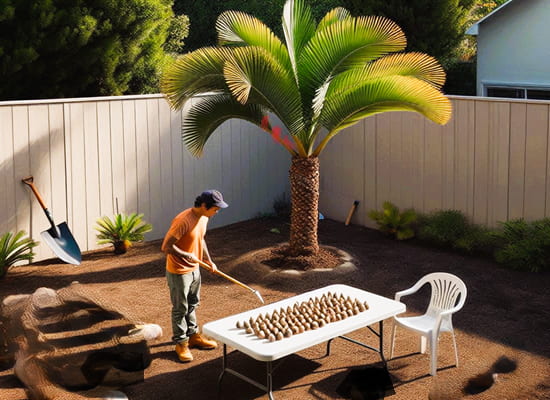
At Mission: Palm Trees
Palm lovers can soothe their palm-related searches and concerns. Our articles are intended to inform, while having fun, easily Finding What You Want or Need. Without unneeded shoptalk & tiring endless research. We Research For You!
Most Common Palm Tree Propagation Methods
The Oxford dictionary defines propagation of plants this way:
"the act of producing new plants from a parent plant"
Several asexual methods of propagating palm trees are available. But they're not used often.
- The most common approach to the propagation of palm trees is called Clonal Propagation.
- Another method is Layering, but usually only used for specific circumstances.
- The least common practice for palm tree propagation (it's more in the experimental category) is by using using a Culture.
Why Isn't Propagation of Palm Trees Used More Often?
Not many people use asexual methods for palm reproduction because palms aren't easily propagated that way.
See our steps for Growing From Seeds, if you decide asexual propagation isn't for you.
Palm Tree Structure is unique in the plant world. Unlike typical trees, their trunk doesn't have a botanical Layer Called Cambium. Which grows new shoots and branches. So traditional "cuttings" won't work.
Asexual propagation must consider these two palm needs for success.
- For palms, new growth comes from the palm tree heart, the growing point at the top of the trunk. Where new fronds are produced. Very few palms have branches.
- Therefore to use clonal propagation, the new palm sourced from the parent requires a way to use a growing point.
- Roots are developed at the trunk's bottom, from the initiation zone.
- Before planting a palm shoot, rooting must be available.
What is Clonal Propagation?
Asexual clonal propagation is also called vegetative propagation.
It really is forming a palm tree clone. Which means a new palm won't come from palm flower pollination. Pollination is the natural process which makes fruit containing a seed. With asexual propagation there is no pollinating of flowers.
Instead, a part of a "parent" palm is used to begin one new palm. The new palm will be a genetic match, a copy of that parent. There are several ways to use this method. In order of more common to less, they are:
- By using offset shoots or suckers
- By using stem layering
- By using bulbils that grow from upper trunk areas
- By using embryo culturing
Let's see the value of each.
Propagating Palms Using Shoots or Suckers
Some palm varieties produce these little offshoots.
Picture a new baby palm growing at the bottom of a palm. Shooting up vertically. This can happen in two ways:
- These shoots grow adjacent to the main palm stem
- These suckers shoot up through the ground from rhizomes.
- Rhizomes are stems that grow underground horizontally, off the main palm trunk. Also called stolons or runners.
These offshoots aren't as common with palms, because many species have only one single trunk. Those solitary palms.
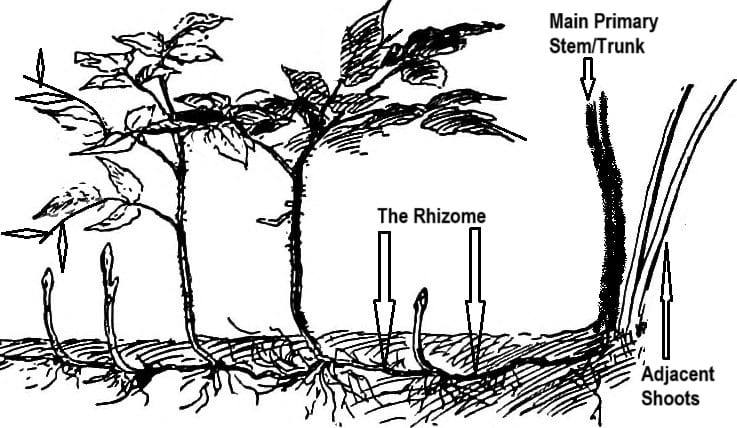 Example to demonstrate offshoots and rhizomes
Example to demonstrate offshoots and rhizomesHow to Begin a Palm with Offshoots
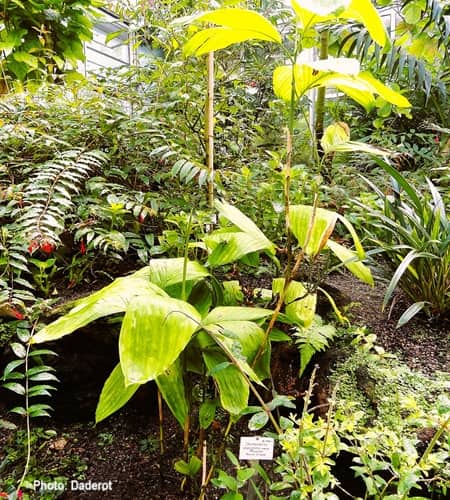 Per its name, C. stolonifera puts out stolons
Per its name, C. stolonifera puts out stolonsClustering palms are the species to work with.
For example, Chamaedorea stolonifera has rhizomes. But C.siefrizii, C.cataractarum & Chamaerops humilis produce suckers.
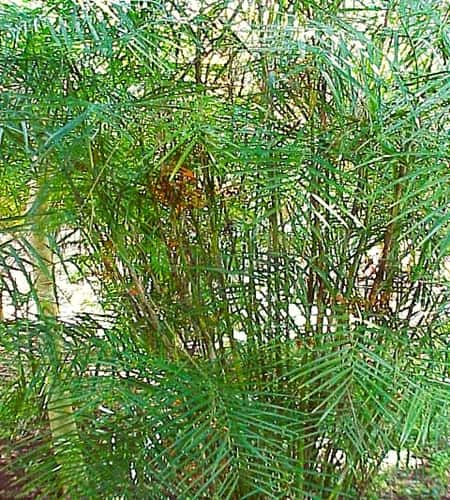 Chamaedorea siefrizii
Chamaedorea siefriziiThe Reed Palm
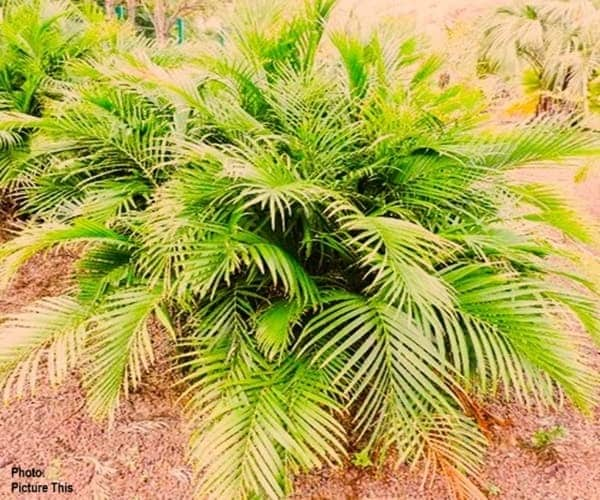 Chamaedorea cataractarum
Chamaedorea cataractarumThe Cat Palm
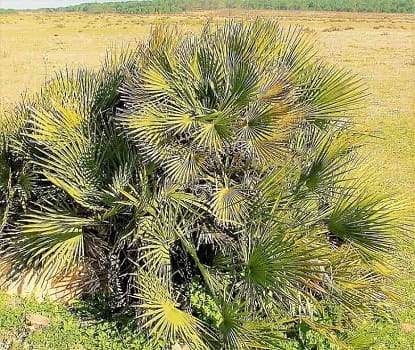 Chamaerops humilis
Chamaerops humilisMediterranean Fan Palm
If you plan to try asexual propagation, look for the offshoot. Carefully clear soil from around its roots.
For easiest success, be sure it has roots. Some just feed off the main palm and don't develop roots. Chrysalidocarpus lutescens is like that.
- Use a sharp spade or knife to slice it from the main trunk. The cut must be smooth. Keep as many roots as possible. You can treat the cut by sealing it with garden lime.
- Plant the offshoot outdoors in a chosen spot. Or pot it, and place it in a mostly shady area.
- Soil level should come to just above where it had been. Water it well & don't allow soil to dry out while being established (1-year).
GET EVEN MORE HELPFUL TIPS WHEN LEARNING HOW TO PROPAGATE PALM PLANTS
FTC Disclosure: If you purchase via a link on this site, we may earn a small royalty. There's no added cost to you. Thanks much for any looks or orders! Details>
We really recommend Palms Throughout the World by David L. Jones. In his chapter called "The Propagation of Palms" 3 pages are devoted to vegetative propagation.
We have it and like the plain talk explanations he uses. See It Here>
Air Layering Steps for Cloning New Palms
Also called stem layering.
It's not too common, because it's a bit more difficult to accomplish. And (again) these types of shoots only happen on specific species, like Chamaedorea species.
Aerial roots pop out on the trunk below frond nodes - the anchor stem for the leaf. These can be used to clone a new palm.
Sphagnum moss is plopped over the aerial root. It's anchored and covered with aluminum foil. When the roots grow into the moss, they can be severed from the new palm. Take the moss-grown roots and plant in a pot.
Water consistently and keep it shaded, until established.
Are Propagating With Palm Bulbils Worth It?
Bulbils are shoots that form on the trunk, somewhere above the ground.
It's rare for palms to produce these. When it does occur, it's only on certain species.
- They often begin as an inflorescence start which has changed its purpose.
- Sometimes they start on secondary frond stems, the secondary rachis.
Likely it won't be worth it to you. Since it's uncommon, I'll not describe where and how bulbils can propagate. You can find details in the book recommended above, or just ask me.
How is Culturing Used for Growing New Palms?
Try culturing (maybe?) if you like being adventurous, and like investigating deeper botanical knowledge.
Two variations are usually done in a lab, because special equipment and processes are needed.
The Tissue Culture Process may be of interest if you have a prized palm for which you'd like to duplicate its genetics. Mostly it's used by professionals working with commercial propagation.
- Tiny tissue sections are taken from a palm.
- The tissue gets nourishment from placement into a sterile culture medium.
The Embryo Culture Process is not vegetative cloning, because it uses seeds. It's the rarest palm propagation system of all. Primarily used in species that have difficulty germinating through the normal Palm Seed Process.
- In the sterility of the lab, pros open a palm seed to retrieve the embryo.
- Propagationists put the embryo into a nutrient filled flask.
- Controlling light, temperature, etc. encourages germination and new growth.
Best Practices for Palms Using Asexual Propagation
Timing is the main key to remember when understanding how to propagate palm plants.
No matter your chosen method, asexual, vegetative propagation is best done during their active growth phase. Which is the warmer months in late spring or early summer.
This way you help ensure the new palm has the best chance to initiate growth. By tamping down their shock and stress, as much as possible.
Growing Palms Comparison - Seeds vs Propagation
Why go through all this effort to learn how to propagate palms from seeds? Because using seeds seems much easier.
- Some people may not want to wait longer for the time if often takes to Grow a Palm From Seed. Since some species can take months, or even years, to germinate.
- By using clonal propagation methods, you can jumpstart that process, bypassing the seed stage altogether.
- Plus, there's the excitement in seeing a new palm plant grow directly from the palm tree you have.
Take a moment to consider the seed method, the go-to for those getting into palm tree propagation.
- You gain the excitement of seeing life spring from its simplest form.
- Seed propagation usually makes stronger, more resilient plants, because it's the natural process.
- Yes, it might test your patience. Solve that by knowing the new growth expectations for how your selected Palm Tree Species grows.
In the end, choose the method that works best for you and your garden. Consider what feels most rewarding in your palm gardening journey.
Whether you succeed in propagating a new plant or simply enjoy the experience, that's what really counts.
How to Propagate Palm Plants - The Takeaways
You might consider going ahead, give it a try!
We hope we got you now have a fair grasp of how to propagate palm plants, beyond using seeds. It's a blend of experiment and enjoyment. While exploring this possibility, let your interest guide you.
To see if you'll take the asexual road, or will you go with Growing Palms from Seeds.

